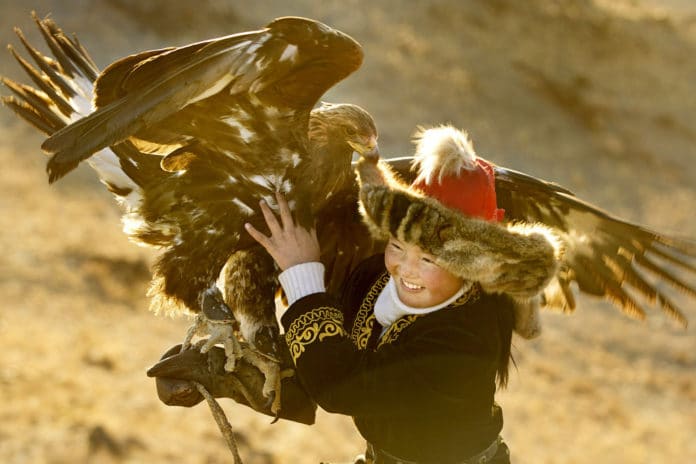Aisholpan Nurgaiv is a 13-year-old girl living with her nomadic family in Mongolia’s Altai mountains, a harsh, unforgiving place of isolation and physical duress. For centuries, her Kazakh family’s tribe has hunted for food and fur with the assistance of golden eagles they train from a young age. Although eagle hunting is traditionally a male purview, Aisholpan has always taken to it and, along with her father, has decided it’s time for her to adopt and train an eagle of her own.
If Aisholpan’s story, told in “The Eagle Huntress,” sounds like a heroine’s journey worthy of fiction at its most mythic and stirring, it most certainly is. But the tale happens to be true. Making a breathtakingly impressive feature-directing debut, documentarian Otto Bell traveled to the far northwest corner of Mongolia to observe Aisholpan not only as she tamed and enlisted the loyalty of an imposing bird of prey but also as she overcame the ingrained sexism of her elders – all while maintaining the same dazzling, serene smile.
With cinematography that soars, swoops and canters across Mongolia’s lunar landscape along with the film’s subjects, “The Eagle Huntress” introduces Aisholpan while she’s at school, in a town so far from her family’s ger, or yurt, that she stays in the dorm all week. Once her father comes to fetch her on his motorcycle, her mind is on mastering the art and cultural practice of eagle hunting, which involves calling to your bird, encouraging it to alight – with its enormous talons – on your gloved arm and training it to seek out rabbits, foxes and other mammals for domestic use. (Eagle hunters keep their birds for seven years, at which point they release them into the wild.)
One of the most jaw-dropping sequences of “The Eagle Huntress” follows Aisholpan and her father as they go out to acquire her eagle – in this case, a young bird that is almost ready to leave the nest. Bell, who worked with a camera crew of two to make the film, climbs down a sheer rock face along with the intrepid young girl, capturing on a GoPro camera an amazing moment when she seems to hypnotize the bird with her hand. A drone and a homemade crane, put together by Bell’s director of photography, Simon Niblett, capture equally dazzling scenery as well as the seemingly endless scale of the Mongolian steppe.
“The Eagle Huntress” eventually finds Aisholpan competing at a hitherto men-only eagle hunting competition and, later, taking her eagle out for its first bona fide hunt. The competition scenes are particularly fun to watch: Not only are the feats of precision and fearlessness on display utterly captivating, but Bell also includes a wittily edited montage of men dismissing Aisholpan’s skills one minute, only to be forced to eat their words the next.
Some viewers may harbor ambivalence as they watch two humans wrest a small eagle from its nest while its mother circles overhead. A later sequence shows Aisholpan and her father putting their birds and horses through a perilously icy journey in 40-below weather to hunt down a fox – not for food, but to take its fur as a prize. (Eagles, presumably, enjoy any meat not fit for human consumption.)
This invites similar ethical questions about hunting for subsistence vs. the symbolic power of the spoils. But for every misgiving “The Eagle Huntress” invites, it offers inspiration in equal measure, taking the audience on a beautiful, thrilling journey to a part of the world that it still largely inaccessible. And it introduces them to a young woman who gives bravery a bracing, unforgettable face.
—
Three and one-half stars. Rated G. Contains nothing objectionable. In Kazakh with subtitles. 87 minutes.
Ratings Guide: Four stars masterpiece, three stars very good, two stars OK, one star poor, no stars waste of time.






